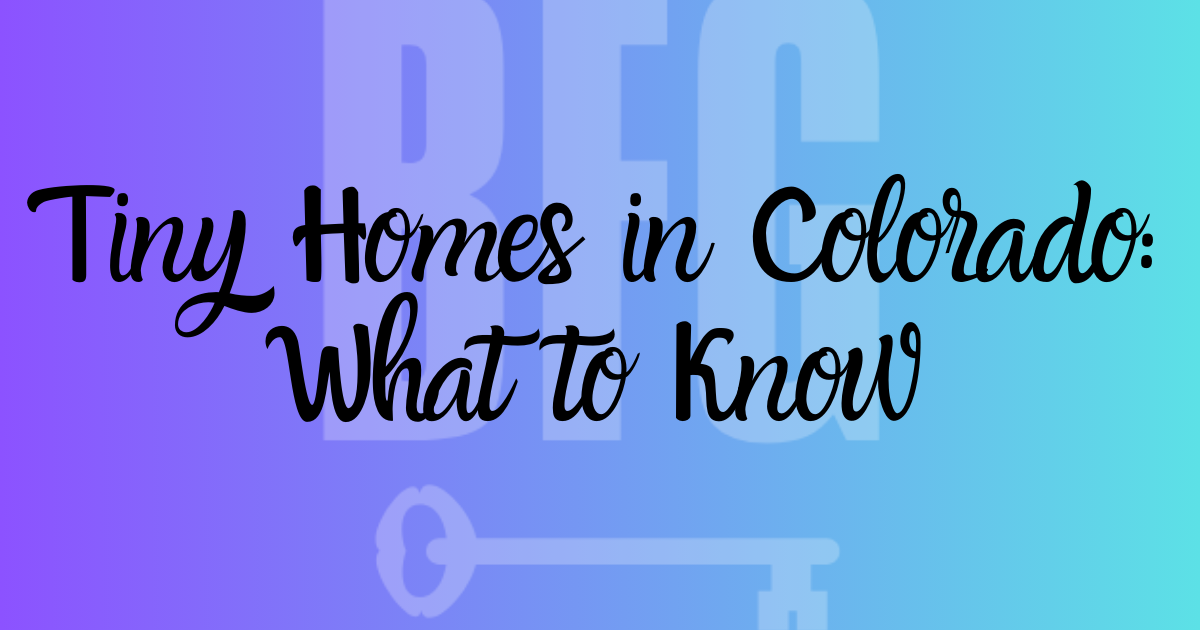Tiny homes have become one of the most talked-about housing trends in Colorado, and for good reason. Between rising construction costs, a growing interest in off-grid living, and the desire for a simpler, more intentional lifestyle, many buyers are considering whether a tiny home could be a smart solution. The short answer is yes—but only if you understand how Colorado’s land use rules, zoning laws, and utility requirements work.
Colorado is a fantastic state for tiny living, yet the regulatory landscape can be confusing. This guide breaks down the practical realities of building or owning a tiny home in Colorado so you can make an informed decision before purchasing land or hiring a builder.
What Counts as a Tiny Home in Colorado?
Colorado doesn’t operate under one statewide rule for defining tiny homes. Instead, homes generally fall into two categories:
Tiny Homes on Wheels (THOWs)
These are built on a trailer chassis and often registered as RVs. They’re portable and flexible but usually considered non-permanent dwellings, which limits where you can legally live in them full-time.
Tiny Homes on a Foundation
These resemble small traditional houses. They’re constructed to residential building codes, typically 100–600 square feet, and they follow the International Residential Code (IRC). These homes offer the most stability and long-term value but still must be placed in zones that allow them.
Understanding Zoning and Land Use in Colorado
This is where most buyers run into challenges. Every county—and often every subdivision—sets its own rules for minimum home size and what types of dwellings are permitted.
More Flexible Counties
Some Colorado counties are known for being tiny-home-friendly, especially in rural regions. These include:
Costilla County
Huerfano County
Custer County
Fremont County
Saguache County
Park County
Portions of Archuleta, Delta, and Montrose Counties
These areas tend to allow small dwellings, modular structures, off-grid utilities, and flexible building styles.
More Restrictive Areas
Front Range metro counties typically have stricter rules, including:
Denver
Boulder
Colorado Springs
Most HOA-controlled subdivisions
These jurisdictions often have minimum square footage requirements and require permanent foundations with full utility hookups.
Common Zoning Rules to Review
Before buying land, always verify:
Minimum dwelling size
Whether RVs/THOWs are allowed for full-time use
Foundation requirements
Water and septic rules
Utility connection regulations
HOA or POA covenants that supersede county rules
This research is essential. Colorado’s zoning landscape is a patchwork, and what works in one county may be prohibited in the next.
Utility Requirements and Off-Grid Options
Tiny homes still require legal access to water, sanitation, and power if they are used as primary residences. Off-grid is possible—but it requires planning and budgeting.
Water
Depending on the parcel, options may include:
Drilled well
Cistern system
Hauled water
Community water systems
Some parcels do not qualify for a well permit, so always confirm before purchasing.
Septic or Sanitation
Most counties require a permitted septic system for full-time living. Composting toilets sometimes qualify, but greywater requirements vary.
Power
Owners may choose:
On-grid electricity
Solar power with battery storage
Hybrid systems with generator backup
In rural counties with full sun exposure—such as Costilla or Huerfano—solar is common and effective.
Financing a Tiny Home in Colorado
Financing depends entirely on how the home is classified.
THOWs (Tiny Homes on Wheels)
These are typically financed like RVs, often with higher interest rates and more restrictions.
Foundation Tiny Homes
If built to residential codes and placed on a permanent foundation, these may qualify for traditional mortgages.
Practical Reality
Many tiny homes in Colorado are purchased with cash or personal loans due to lending limitations and appraisal challenges.
Insurance Considerations
Insurance varies by structure type:
THOWs: RV insurance
Park models: Manufactured home policies
Foundation homes: Standard homeowners insurance
The insurer will also ask whether this is a primary residence or a seasonal home, which affects coverage.
Colorado’s Pros and Cons for Tiny Living
Advantages
Lower cost of living
Sustainable lifestyle
Works well on rural acreage
Strong off-grid communities
Easy to heat and maintain
Challenges
Zoning restrictions
Winter access and snow management
Septic and utility costs
Limited financing options
Resale market is more niche
For buyers who value independence, small-footprint living, and Colorado’s open spaces, the lifestyle is rewarding. For others, the regulatory and utility requirements can feel overwhelming without guidance.
Best Regions in Colorado for Tiny Homes
Based on zoning flexibility, land prices, and lifestyle fit, popular areas include:
San Luis Valley (Costilla, Alamosa, Saguache)
Huerfano County (La Veta, Walsenburg, Gardner stretches)
Fremont & Custer Counties
Park County
Western Slope pockets (Montrose, Delta, Ouray counties)
If you want an easier permitting experience and more freedom, these regions are a strong starting point.
Checklist for Evaluating Land for a Tiny Home
Before making an offer, confirm:
Zoning classification
Minimum square footage
Water eligibility (well or cistern)
Septic requirements
Road access year-round
Power options (solar or grid)
Cell service and internet availability
HOA or POA rules
Setback requirements
Terrain and site preparation costs
This checklist helps prevent common (and costly) surprises for first-time buyers.
What Does It Really Cost to Set Up a Tiny Home in Colorado?
Budget ranges vary widely depending on location and terrain, but these estimates offer a realistic starting point:
Tiny home construction: $40,000–$200,000
Land: Highly variable
Septic system: $10,000–$25,000
Well drilling: $15,000–$35,000
Solar power system: $8,000–$25,000+
Driveway and road cut: $2,000–$30,000
Site leveling/excavation: $1,000–$10,000+
Permits: $500–$3,000+
In many cases, site development costs exceed the price of the tiny home itself.
How Big Frontier Group Helps Tiny-Home Buyers
Our team works with clients across Colorado to find land and properties suitable for tiny living. We help by researching:
Zoning rules and minimum dwelling sizes
Well, septic, and utility permissions
Off-grid options and solar suitability
Subdivision covenants and county restrictions
Winter access and terrain considerations
We take a lifestyle-first approach, helping buyers find land that matches their goals—whether that’s seasonal use, full-time off-grid living, short-term rental potential, or long-term homesteading.
Final Thoughts
A tiny home in Colorado can be an excellent choice for anyone looking to simplify their life, reduce housing costs, or live closer to nature. The key is understanding the regulations and land requirements before you build or buy. With the right expectations—and the right piece of land—tiny living in Colorado can be both practical and rewarding.


